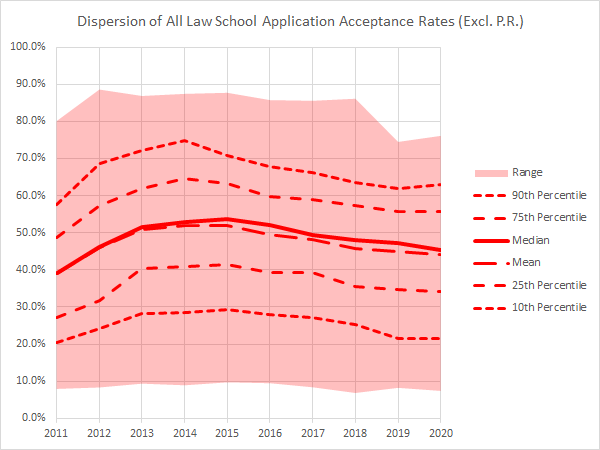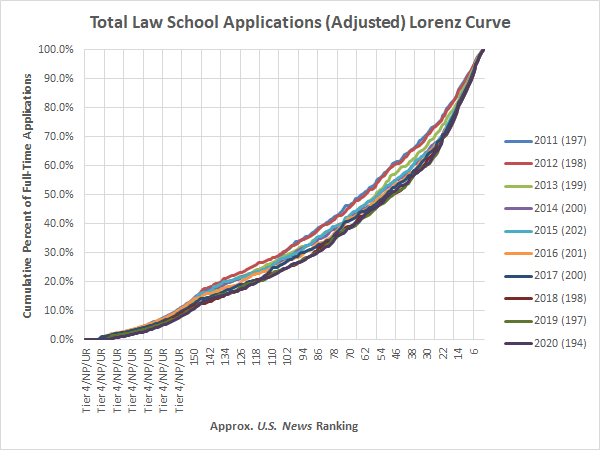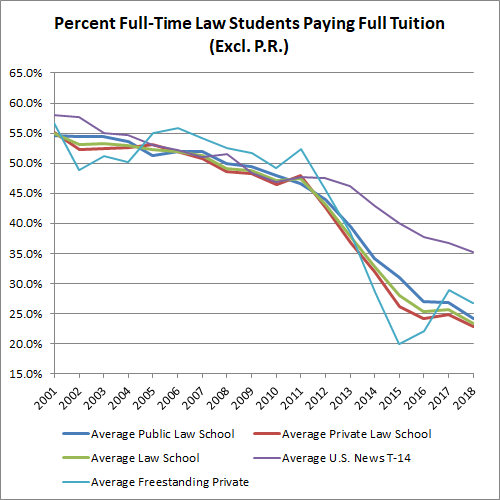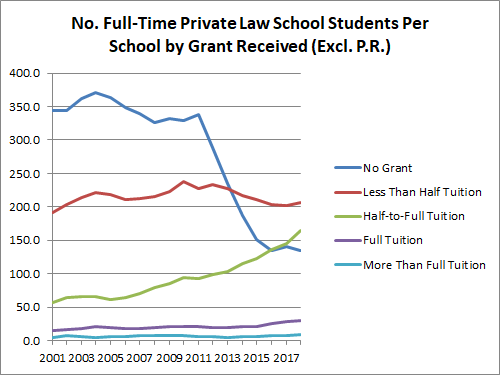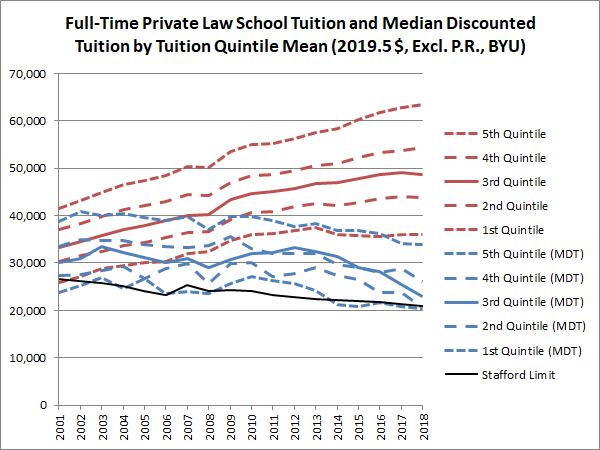Good morning, folks! Law-school-employment data are in, and before there’s a revision, this post will depict what they show. As with last year, I’m going to start with the headline information and save the law-school-level ranking of shame for later.
To begin with, here’s the table of graduate underemployment. (Everything on this post excludes the three Puerto Rico law schools.)
| STATUS (EXCL. P.R.) |
2010 |
2011 |
2012 |
2013 |
2014 |
2015 |
2016 |
2017 |
2018 |
| Unemployed – Not Seeking |
1,245 |
1,014 |
939 |
795 |
553 |
494 |
469 |
441 |
387 |
| Unemployed – Seeking |
2,686 |
4,016 |
4,770 |
5,060 |
4,103 |
3,744 |
3,142 |
2,610 |
2,348 |
| Status Unknown |
1,458 |
1,453 |
1,073 |
979 |
841 |
766 |
557 |
437 |
444 |
| Total Grads |
43,526 |
43,735 |
45,757 |
46,112 |
43,195 |
39,423 |
36,619 |
34,393 |
33,751 |
| Unemployed – Not Seeking |
2.9% |
2.3% |
2.1% |
1.7% |
1.3% |
1.3% |
1.3% |
1.3% |
1.1% |
| Unemployed – Seeking |
6.2% |
9.2% |
10.4% |
11.0% |
9.5% |
9.5% |
8.6% |
7.6% |
7.0% |
| Status Unknown |
3.3% |
3.3% |
2.3% |
2.1% |
1.9% |
1.9% |
1.5% |
1.3% |
1.3% |
| Total Percent |
12.4% |
14.8% |
14.8% |
14.8% |
12.7% |
12.7% |
11.4% |
10.1% |
9.4% |
As with the last few years, overall underemployment fell faster than the number of graduates. The rate of decline appears to be slowing, which isn’t good, but it’s still progress.
On the reverse side, 69.2 percent of graduates found full-time long-term work in bar-passage-required jobs. Last year, that figure was 67.0 percent, so it’s a two-percent jump. In three years, the percentage has risen by 6.7 points, which is quite notable. However, the rate of improvement appears to be slowing, even if the actual number of graduates finding these jobs rose by 300.
So what’s different this year? Let’s take a look at the analytic tables that compare this year to last year.
| EMPLOYMENT STATUS |
NO. OF GRADS |
GRADS PCT. OF TOTAL |
PCT. CHANGE IN GRADS |
DISTRIBUTION OF CHANGE IN GRADS |
GINI COEFFICIENT |
| 2017 |
2018 |
2017 |
2018 |
2018 |
2018 |
2017 |
2018 |
| Employed – Bar Passage Required |
23,936 |
23,922 |
69.6% |
70.9% |
-0.1% |
2.2% |
0.34 |
0.34 |
| Employed – JD Advantage |
4,027 |
4,018 |
11.7% |
11.9% |
-0.2% |
1.4% |
0.38 |
0.37 |
| Employed – Professional Position |
1,091 |
991 |
3.2% |
2.9% |
-9.2% |
15.6% |
0.54 |
0.55 |
| Employed – Non-Professional Position |
399 |
346 |
1.2% |
1.0% |
-13.3% |
8.3% |
0.55 |
0.63 |
| Employed – Law School |
604 |
515 |
1.8% |
1.5% |
-14.7% |
13.9% |
0.79 |
0.80 |
| Employed – Undeterminable |
23 |
32 |
0.1% |
0.1% |
39.1% |
-1.4% |
0.92 |
0.90 |
| Employed – Pursuing Graduate Degree |
535 |
480 |
1.6% |
1.4% |
-10.3% |
8.6% |
0.52 |
0.55 |
| Unemployed – Start Date Deferred |
290 |
268 |
0.8% |
0.8% |
-7.6% |
3.4% |
0.58 |
0.58 |
| Unemployed – Not Seeking |
441 |
387 |
1.3% |
1.1% |
-12.2% |
8.4% |
0.52 |
0.53 |
| Unemployed – Seeking |
2,610 |
2,348 |
7.6% |
7.0% |
-10.0% |
40.8% |
0.43 |
0.42 |
| Employment Status Unknown |
437 |
444 |
1.3% |
1.3% |
1.6% |
-1.1% |
0.66 |
0.71 |
| Total Graduates |
34,393 |
33,751 |
100.0% |
100.0% |
-1.9% |
100.0% |
0.29 |
0.30 |
| EMPLOYMENT TYPE |
NO. OF GRADS |
GRADS PCT. OF TOTAL |
PCT. CHANGE IN GRADS |
DISTRIBUTION OF CHANGE IN GRADS |
GINI COEFFICIENT |
| 2017 |
2018 |
2017 |
2018 |
2018 |
2018 |
2017 |
2018 |
| Solo |
438 |
368 |
1.3% |
1.1% |
-16.0% |
10.9% |
0.58 |
0.59 |
| 2-10 |
5,771 |
5,485 |
16.8% |
16.3% |
-5.0% |
44.5% |
0.33 |
0.34 |
| 11-25 |
1,694 |
1,731 |
4.9% |
5.1% |
2.2% |
-5.8% |
0.42 |
0.41 |
| 26-50 |
998 |
1,050 |
2.9% |
3.1% |
5.2% |
-8.1% |
0.45 |
0.45 |
| 51-100 |
800 |
850 |
2.3% |
2.5% |
6.3% |
-7.8% |
0.48 |
0.46 |
| 101-250 |
977 |
1,016 |
2.8% |
3.0% |
4.0% |
-6.1% |
0.51 |
0.48 |
| 251-500 |
1,003 |
957 |
2.9% |
2.8% |
-4.6% |
7.2% |
0.64 |
0.63 |
| 501-PLUS |
4,611 |
4,777 |
13.4% |
14.2% |
3.6% |
-25.9% |
0.77 |
0.76 |
| Unknown |
96 |
99 |
0.3% |
0.3% |
3.1% |
-0.5% |
0.85 |
0.87 |
| Business Industry |
4,149 |
3,841 |
12.1% |
11.4% |
-7.4% |
48.0% |
0.36 |
0.36 |
| Government |
4,132 |
4,101 |
12.0% |
12.2% |
-0.8% |
4.8% |
0.32 |
0.33 |
| Public Interest |
1,618 |
1,679 |
4.7% |
5.0% |
3.8% |
-9.5% |
0.48 |
0.48 |
| Federal Clerkship |
1,171 |
1,190 |
3.4% |
3.5% |
1.6% |
-3.0% |
0.69 |
0.69 |
| State/Local Clerkship |
2,048 |
2,130 |
6.0% |
6.3% |
4.0% |
-12.8% |
0.58 |
0.58 |
| Other Clerkship |
25 |
27 |
0.1% |
0.1% |
8.0% |
-0.3% |
0.92 |
0.95 |
| Education |
481 |
462 |
1.4% |
1.4% |
-4.0% |
3.0% |
0.48 |
0.52 |
| Unknown Employer Type |
66 |
70 |
0.2% |
0.2% |
6.1% |
-0.6% |
0.91 |
0.90 |
| Total Employed by Type |
30,078 |
29,833 |
87.5% |
88.4% |
-0.8% |
38.2% |
0.31 |
0.31 |
In ’18, there were 642 fewer graduates than in 2017, a decline of 1.9 percent. By comparison, last year I reported a drop of 6.1 percent. Because the change in graduates is mild this year it’s not so easy to pick apart the data to identify clear trends. Nevertheless, the three biggest employment statuses contributing to the decline were: Unemployed – Seeking (40.8%), Employed – Professional Position (15.6%), and Employed – Law School (13.9%). The total here is 70.2 percent.
Changes among the employment types accounted for just 38.2 percent of the 642 fewer graduates, and the categories are quite polarized. Business Industry (+48%), 2-10-lawyer practices (+44.5%), State/Local Clerkship (-12.8%), and 501-plus-lawyer firms (-25.9%). That is to say, Business Industry jobs fell and clerkships rose, etcetera.
Here’s a link to my discussion of what Gini coefficients mean. They vary little year by year, so there’s not much of a reason to discuss them beyond the disgustingly out-of-reach federal clerkships.
Editorial: This year’s employment report is the first in a while that was a bit muddy because the graduate crash is leveling off. Still, it appears more grads were able to find jobs, those jobs were better overall, and law-firm jobs are shifting away from smaller practices to much larger ones. These are good trends in principle. Mostly though, I would hesitate to read too much into an employment report that differs so little from last year’s.
Similar editions of this post from prior years can be found here:
